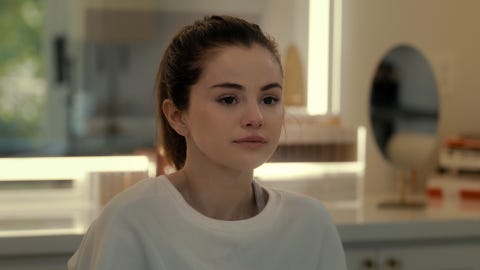What Selena Gomez Shared About Her Psychotic Episode, Living With Bipolar, and Overcoming Suicidal Thoughts
Few celebrities have shared as much detail about their mental health struggles as Selena Gomez did in My Mind and Me. The documentary, filmed over six years, brought to light what Gomez privately endured when she retreated from the public eye, including a scary episode of psychosis in 2018 that led to a diagnosis of bipolar disorder.
Here’s what the documentary and Gomez herself revealed in interviews promoting the film about bipolar disorder and what she has done to treat it.
Gomez detailed what her manic and depressive episodes are like.
In My Mind and Me, Gomez revealed she got her bipolar diagnosis after having an episode of psychosis in 2018. To Rolling Stone, she explained in more detail with her manic and depressive episodes have been like.
“I’m going to be very open with everybody about this: I’ve been to four treatment centers,” Gomez said. “I think when I started hitting my early twenties is when it started to get really dark, when I started to feel like I was not in control of what I was feeling, whether that was really great or really bad.”
Highs and lows could last weeks or months at a time, and she couldn’t identify their triggers. As Rolling Stone wrote, “Sometimes, she wouldn’t be able to sleep for days. She’d be convinced she needed to buy everyone she knew a car, that ‘I have a gift and I wanted to share it with people’— a symptom of mania complicated by the fact that, in her case, it was kind of true.”
On the lows, “it would start with depression, then it would go into isolation,” she said. “Then it just was me not being able to move from my bed. I didn’t want anyone to talk to me. My friends would bring me food because they love me, but none of us knew what it was. Sometimes it was weeks I’d be in bed, to where even walking downstairs would get me out of breath.”
Gomez canceled her Revival tour after 55 shows because her mental health got so bad, she was contemplating suicide.
At the time, Gomez put out a statement saying she was ending the tour to deal with her lupus along with anxiety and depression. The documentary showed her taking her blood pressure before shows and living with the autoimmune disease while touring.
“As many of you know, around a year ago I revealed that I have lupus, an illness that can affect people in different ways,” she told People in a statement on August 30, 2016. “I’ve discovered that anxiety, panic attacks and depression can be side effects of lupus, which can present their own challenges. I want to be proactive and focus on maintaining my health and happiness and have decided that the best way forward is to take some time off.”
The documentary painted the grimmer reality happening.
As her former assistant Theresa Mingus explained in the film, “At one point, she’s like, ‘I don’t want to be alive right now. I don’t want to live.’ And I’m like, ‘Wait, what?!’ And it was one of those moments where you look in her eyes, and there’s nothing there. It was just pitch black. And it’s so scary. You’re like, ‘Fuck this. This needs to end. We need to go home.’”
Her friend Raquelle Stevens added, “We had to have a really serious conversation with her of ‘what is going on?’ Her answer was also like, ‘I don’t know. I can’t explain it. I wish you could feel what it feels like to be in my head.’ I just remember it being very chaotic, and she was hearing all of these voices. They just kept getting louder and louder and louder that triggered some sort of psychotic break.”
Gomez addressed her suicidal thoughts in her Rolling Stone interview, saying she never actually attempted but “spent a few years contemplating it,” the outlet wrote.
“I thought the world would be better if I wasn’t there,” she said.
Gomez’s 2018 psychiatric hospital stay was prompted by her having an episode of psychosis.
In October 2018, TMZ reported that Gomez was hospitalized twice because of low white blood cell counts. People reported at the time that Gomez underwent dialectical behavior therapy for anxiety and depression after having a panic attack in the hospital during her second visit. “She has had a tough few weeks and the panic attack in the hospital was the tipping point,” a source told the outlet then. “She realized she needed to seek additional help for her ongoing emotional issues. She’s surrounded by close family and has a lot of support. She’s doing better now and is seeking treatment on the East Coast.”
Gomez, her mother Mandy Teefey, and friend Raquelle Stevens revealed in the documentary that Gomez had been suffering from psychosis.
Teefey, with whom Gomez had a strained relationship with at the time, said, “We heard about her mental breakdown through TMZ. They called me and wanted to know what my daughter was doing in the hospital with a nervous breakdown. She didn’t want anything to do with me, and I was scared she was going to die.”
“You hang on as tight as you can and try to help them with their treatment, and that’s the hardest thing to do, to then just go to bed and hope that they wake up the next day,” she added, crying. “It’s a miracle she got out. But there’s always the fear that that’s going to happen again, and it hurt us so much.”
Stevens added, “If anybody saw what I saw in the state that was she in at the mental hospital, they wouldn’t have recognized her at all, and I was devastated because psychosis can last from days to weeks to months to years to life.”
Rolling Stone‘s cover story addressed Gomez’s memories of her time there and that she started hearing voices in 2018. She “only remembers snippets of this time, but she knows she ended up in a treatment facility, where she spent several months suspended in paranoia, unable to trust anyone, thinking they were all out to get her. Her friends have since told her that she was unrecognizable during this period,” the outlet wrote.
Gomez said she found herself slowly “walking out of psychosis,” she said. She was diagnosed with bipolar then and put on a lot of medications as doctors figured out what worked for her.
Gomez hadn’t wanted to go to a mental health hospital but knew she needed to in order to save herself.
Gomez said in the documentary, “I found out that I have a diagnosis of bipolar disorder. I’m going to be honest: I didn’t want to go to a mental health hospital. I didn’t want to but I didn’t want to be trapped in myself and my mind anymore. I thought my life was over. I thought this is how I’m going to be forever. That’s why I say to people that I have the greatest friends and family, especially my mom and my stepdad Brian, because I shouldn’t have spoken to them the way I did,” she added, crying. “I shouldn’t have treated them the way that I did sometimes. And they know it wasn’t me so then when I wake up the next day, they tell me what happened but they explain to me, they’re like, ‘Look, I know that that’s not you talking. And we’re really concerned and you know, just know that we love you. We don’t see anything different from what was last night to now. But if I talk about it to them, I just say it over and over again. I say I’m so sorry because I remember certain things that I did and I was so mean. And so like even to this day, I keep saying thank you and I’m sorry and everything that I do and they’re always like, once we found out everything, it made so much sense, Selena. You’re the best that you’ve ever been and we’re so happy that we can see that. And we never ever would give up on you. And they haven’t when in so many times, they probably should’ve.
“When I first got out, I didn’t know how I’d cope with my diagnosis,” she added. “What if it happened again? What if the next time, I didn’t come back? I needed to keep learning about it. I needed to take it day by day.”
Gomez worked with a psychiatrist after her stay to get on the right drug regiment, after feeling like she was “gone” being on all the drugs she was initially on.
Initially in the facility, on all the drugs doctors gave her to try to treat her newly-diagnosed bipolar disorder, “it was just that I was gone,” she told Rolling Stone. “There was no part of me that was there anymore.”
Once Gomez left, she found a psychiatrist who “realized she was on a lot of medications she shouldn’t have been on and pulled her off all but two,” Rolling Stone wrote.
“He really guided me,” Gomez said. “But I had to detox, essentially, from the medications I was on. I had to learn how to remember certain words. I would forget where I was when we were talking. It took a lot of hard work for me to (a) accept that I was bipolar, but (b) learn how to deal with it because it wasn’t going to go away.”
Gomez’s bipolar medication may prevent her from being able to carry children on her own.
Gomez addressed the very real effect that treating her bipolar disorder has on her future as a potential mother to Rolling Stone. Staying on the two medications she needs to take for bipolar disorder means “that she likely won’t be able to carry her own children,” Rolling Stone wrote.
“That’s a very big, big, present thing in my life,” she said, adding that she’s convinced that “however I’m meant to have them, I will.”
You can watch My Mind and Me on Apple TV+ now here.
If you or someone you know is at risk, you can call the National Suicide Prevention Lifeline at 988 or 1-800-273-TALK (8255) or text HOME to 741741 to message with a trained crisis counselor from the Crisis Text Line for free. You can find more resources on their site here.
Alyssa Bailey is the senior news and strategy editor at ELLE.com, where she oversees coverage of celebrities and royals (particularly Meghan Markle and Kate Middleton). She previously held positions at InStyle and Cosmopolitan. When she’s not working, she loves running around Central Park, making people take #ootd pics of her, and exploring New York City.



